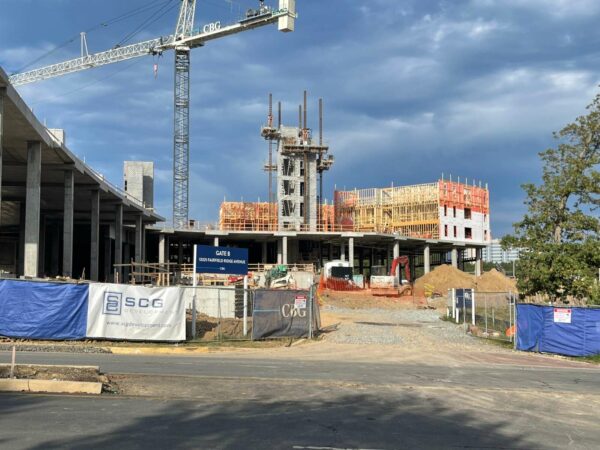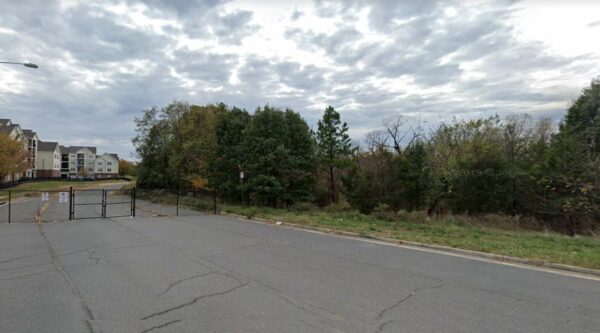A developer wants to repaint buildings and add a bike locker station if the town allows the company to redevelop the Herndon Residence Inn into multifamily housing.
The Denver-based hospitality business Stonebridge Companies bought the nearly 6.5-acre Residence Inn property in February 2020 for $17.25 million and has been working for over a year to get the property approved for reuse as multifamily housing. It would include affordable (so-called “workforce“) housing and market-rate units.
The town’s Architectural Review Board is reviewing proposed exterior changes and is slated to meet tonight (Wednesday) at 7:30 p.m.
A town memo provides the following context on how the review board’s decision will affect the application:
The board’s preliminary review and feedback is part of the official review process of a Zoning Map Amendment (ZMA) land use case currently in review for the conversion project. Following board review, the ARB chair will produce a report of the Board’s findings and provide it to the Planning Commission for consideration during its deliberation of the ZMA case. The project will return to the ARB as a formal item following approval of the ZMA and a site plan.
Among the changes, the bike locker station would be about 24 feet wide by 24 feet long and 6 feet high. Additionally, a refuse and recycling station would be added, but the applicant didn’t provide renderings at this point, according to the town.
Town staff said the proposed exterior changes are both acceptable and would help with the general improvement of the “out-of-date” hotel.

Developers may need to add more affordable houses to address Loudoun County’s concerns over a 103-acre mixed-use project by the future Innovation Center Metro station.
The developers of the Rivana at Innovation Station have tried to justify how they’re meeting affordability needs, but Loudoun County officials have raised issues over how the project’s concessions will play out if only 170 units of a project will be affordable. The development could have up to 2,719 units.
Envisioning a 9 million square-foot, “walkable urban center that is directly connected to the Innovation Center Metro station,” developers wanted to start construction in the first quarter of this year. They previously shared plans involving a performing arts venue and two public parks as part of the project that would drastically redefine the area.
Antonio Calabrese, a partner with the multinational law firm DLA Piper, has countered that the developers’ project would include 6.25% of Unmet Housing Needs Units, which the county defines as units serving households that are at or below the area media income.
In a Dec. 6 letter to the county’s Department of Planning and Zoning, Calabrese also stated the developers’ percentage of affordable units is consistent with multiple rezoning requests of projects near Metro stations.
But in early September, the Loudoun County Board of Supervisors adopted a strategic plan that calls for a 20% affordability goal.
“This Application does not adequately address affordability in the current proposal,” Brian Reagan, the county’s housing programs manager, said in an Oct. 12 memo about the project’s second submission.
Loudoun County’s chair, Phyllis Randall, told Reston Now that the developers’ 6.25% rate of affordability is too low but questioned whether 20% was attainable there, citing high property values along the Metro line.
She said the county’s affordability goal is a guideline that helps navigate discussions with developers, noting it’s a place where conversation begins but doesn’t end.
“We don’t want to see brakes on the project,” Randall said. “We’d like to see it come to fruition.”
She also noted that the county for the first time is setting aside half a penny of property taxes to add to its housing trust fund, which could generate nearly $6 million per year, part of the county’s efforts to address equity.
Other affordability concerns raised
The Rivana application, and a subsequent updated proffers list dated Dec. 6, also called for the affordable units as being reserved for those making at or below 40%, 60% or 80% of the area median income.
But Loudoun County’s housing program manager has questioned that approach, too, saying that the breakdown should mirror existing housing programs there, which involve households making at or below 30%, 50%, 70% and 100% of the area median income.
Calabrese, the attorney, stated that the developers couldn’t determine the likely breakdown of rental apartment buildings and residential condominium buildings at that time and restated the developers’ ratios.
“The Applicant’s proposed development involves a long-term, multi-phased project consisting of substantial office, hotel, residential, and commercial uses,” Calabrese also wrote.
Reagan has also questioned whether the project will even have residential units for sale, noting that the first phase of the project is devoted to rental units.
The developers’ lawyer countered that it will “depend on the rental market and the condominium market” at that future time.
According to the Loudoun County Economic Development Authority, Novais Partners is the master developer of the property, which involves a partnership between Origami Capital Partners, Timberline Real Estate Partners, Open Realty Advisors and Rebees. Novais is a codeveloper of Rivana with the Hanover Co.
The application’s developers are DWC Holdings and Origami RE Growth GP, both linked to Chicago-based investment firm Origami Capital Partners.
 This is an opinion column by Del. Ken Plum (D), who represents Reston in Virginia’s House of Delegates. It does not reflect the opinion of Reston Now.
This is an opinion column by Del. Ken Plum (D), who represents Reston in Virginia’s House of Delegates. It does not reflect the opinion of Reston Now.
Fewer Virginians can afford to buy a home, and there is a shortage of at least 200,000 affordable rental units according to the results of a study by the staff of the Joint Legislative Audit & Review Commission (JLARC) released earlier this week. Much of the material in this column is taken directly from the report which is available to the public at jlarc.virginia.gov. The study was undertaken at the direction of the legislative members of JLARC including myself as chairman and Senator Janet Howell as vice chairman to give basic information to the General Assembly for its legislative action as needed.
As expected, Virginians most affected by the lack of affordable housing are renters who have low income. Households are considered housing-cost burdened when they spend more than 30 percent of their income on housing expenses. Approximately 29 percent of Virginia households (905,000) were housing-cost burdened in 2019, and nearly half of these households spent more than 50 percent of their income on housing putting Virginia near the middle of states in terms of the percentage of households that are cost burdened.
Not surprisingly, the study found that households that rent their homes are more likely to be cost burdened than households that own their homes. Approximately 44 percent of renting households are cost burdened compared with 21 percent of owning households. The majority (67 percent) of cost burdened households live in the state’s so called “Golden Crescent” of Hampton Roads, Northern Virginia, and Central Virginia.
There is a relationship between housing-cost burdened individuals and their occupations, many of which are in high demand. Examples include home health aides ($22,000 salary), teaching assistants ($29,000 salary), and social workers ($51,000 salary) who are needed in all parts of the state, and a lack of affordable housing in some regions constrains the supply.
The JLARC report states that the median home sales price in Virginia has risen 28 percent over the past four years to $270,000 in 2021. The percentage of all Virginia homes that sold for $200,000 or less decreased by 40 percent since 2019. In addition to the rising cost of homes are the upfront costs required to purchase a home. Renting a home is an obvious alternative to home purchasing, but the shortage of 200,000 affordable rental units adds to the problem. The shortage of affordable rental units in Fairfax County alone is estimated to be 80,000.
Possible solutions to the not-so-affordable housing in Virginia suggested by JLARC for state legislative action include a greater contribution to the state’s funding for affordable housing of both new affordable multi-family housing and rental housing. The state needs to provide better assistance with upfront mortgage costs. Local zoning affects the affordable housing supply and needs to be examined and revised. Virginia needs to give additional localities the authority to require developers to set aside a portion of units to rent or sell below market price.
There is no place like home for the holidays–or for any time of the year. There is a responsibility that government respond to the need for affordable housing.

Construction crews are moving forward on an affordable residential complex at Arrowbrook Centre by the Dulles Toll Road and Centreville Road.
As of Thursday, owner SCG Development reported it had completed 31% of the project, dubbed Ovation at Arrowbrook, setting its sights on an early 2023 completion.
“We will begin pre-leasing units at the end of 2022,” Jennifer Schneider, SCG vice president of development, said in an email.
The project will make 274 affordable apartment homes for households earning between 30 and 60 percent of the area median income. It will remain designated as affordable for at least 50 years.
The development will include 55 three-bedroom units and 15 handicap-accessible units.
It will be located next to Arrowbrook Center Park, a townhome and condominium community that Pulte will develop. A high-rise building with a hotel, offices, and condominiums is also planned on the site, Reston Now previously reported.
The development puts it next to a soccer field and the forthcoming Innovation Center Metro station. Other projects nearby going up by the transit stop include Passport apartments and Liberty Park condos and townhomes.
House of Delegates candidates answered questions on a range of issues that they could face in Richmond, giving voters a firsthand look at their viewpoints.
The nonprofit Cornerstones hosted the forum online with 36th District candidates Matt Lang, a Republican security consultant and veteran, and incumbent Ken Plum, a Democrat who has held the office since 1982.
For the 86th District race, the forum also featured candidates Julie Perry, a Republican high school history teacher, and Irene Shin, who won the Democratic Primary in June to take the nomination away from incumbent Ibraheem Samirah.
Candidates fielded questions from panelists and the audience in the hourlong event. A recording of the forum was slated to be posted on Cornerstones’ website.
Extending child care subsidy
Panelist Nasia Ashkir noted a federal subsidy for child care will end in December, and she asked if candidates would support extending it with leftover American Relief Act Money.
Plum shared his support for doing so and noted that he wrote about the issue for a column this month. He cited research showing how kids who received pre-school education have been linked to less societal costs, mainly in the area of crime.
Lang also said he’s support such an extension and would want to look for how to fund it once the federal aid runs out in ways that don’t raise taxes.
“Like Del. Plum just said, children are the future,” the Reston resident said. “Their education and their foundation is going to be our success down the road.”
Addressing affordable housing
Pastor Stephen Smith-Cobbs, who served as the forum’s second panelist, noted how $4.3 billion in flexible funding is available through ARPA but hasn’t been spent so far in affordable housing.
“Many people who work in Fairfax County simply can’t afford to live here,” Smith-Cobbs said, asking what candidates’ plans were for increasing the stock in affordable housing.
Both Republican candidates noted concerns with long-term assistance.
“If we help them forever, they’re never going to have the incentive to want to try their best and shine in society,” Perry said, adding that everybody can live the American dream.
Shin, the executive director of the nonprofit Virginia Civic Engagement Table, which looks to support progressive organizations, said she would support fully funding the Virginia Housing Trust, saying it incentivizes developers to make affordable housing.
Lang also said that increasing the supply of rental units or homes could help reduce the sales of existing homes, and lowering prices of other things, such as fuel taxes, would help put more money in people’s pockets.
His opponent said Cornerstones serves as a model for how to go forward by providing comprehensive services, such as child care and job training. Plum also said he expects the governor’s upcoming budget proposal to increase affordable housing investments, such as by working with organizations, setting up land conservation trusts and pursuing other efforts to leverage public money.
An entity that launched to serve those in need over 50 years ago is celebrating its successes and looking at what’s ahead in order to help others.
What began as religious organizations coming together, the outreach once known as Reston Interfaith has evolved into community centers providing everything from recreational needs to social services, a 24/7 70-bed homeless shelter, over 100 affordable homes and more.
“The single-most-important thing we built is a reputation for reliable, low-drama services to our neediest neighbors,” said Larry Schwartz, chair of Cornerstones’ Board of Directors.
The homeless shelter now bears the name of Embry Rucker, a businessman turned pastor who sought to avoid building churches and instead focus on social services.
As the region changes, the nonprofit expects to double the housing stock it owns, which currently allows people to live in affordable housing while capping families’ costs at 30% of their income.
The Reston-headquartered organization has grown with its donors and volunteers, where before the COVID-19 pandemic it had around 6,000 people helping annually. Their efforts range from aiding Thanksgiving food drives to helping out with winter clothing campaigns.
During the pandemic, the organization also obtained $1.6 million in CARES Act relief to people in need, Schwartz said.
The pandemic was a factor in delaying the organization’s celebration of its 50-year milestone, causing a fundraising gala to be held during the organization’s 51st year now in 2021. It will take place virtually and in person on Sept. 30.
The organization is also highlighting its progress throughout the decades with a gallery of photos capturing key moments, including the opening of the Laurel Learning Center (11484 Washington Plaza West, Suite 200 in Reston) and its expansion with an infant and toddler day care named after former Reston Interfaith CEO Connie Pettinger.
As the cost of childcare can cost over $12,000 per kid before they reach preschool, Cornerstones scholarships and Fairfax County assistance help families get the support they need.
“The families can afford quality childcare while they’re outside the home trying to build the home,” Schwartz said.
Cornerstones’ Herndon Neighborhood Resource Center (1086 Elden St.) at the Dulles Park Shopping Center serves as a one-stop-shop for social services ranging from financial counseling to legal services for immigrants and job training as well as housing a health care center.
While the organization has its roots with religious groups, it changed its name in 2013 as it’s sought to be more inclusive with businesses, civic and community organizations, foundations and other supporters. Nevertheless, the group noted the new name, Cornerstones, is one that “has meaning in many of our faith traditions,” a letter by CEO Kerrie Wilson said.
Currently, Wilson describes Cornerstones as being at the front end of responding to eviction challenges amid the pandemic and helping families stabilize and ensure they have the support they need.
She noted that policies put in place years ago as a country have influenced how people are stuck in poverty and created barriers for home ownership.
“We will continue to serve on the frontlines,” she said, “But I think the biggest additional change and emphasis for us has to be the work in changing policies and systems that will let us truly end hunger and ensure that all families … have that first chance at home ownership.”
Photo via Cornerstones/Instagram

Faced with challenges from providing affordable housing to mitigating flooding, Fairfax County has its hands full, but it’s currently armed with vacant property assessed at tens of millions of dollars.
Currently tax-exempt, the properties could be used for commercial development, environmental preservation, housing projects, recreation, or stormwater drainage, among other purposes.
“There is a critical shortage of affordable housing options in Fairfax County,” Dranesville District Supervisor John Foust said when asked about what the county should do with its vacant properties.
The total financial value of vacant, county-owned properties exceeds $50 million, as calculated based on a public records request and assessments in an online county database for over 100 parcels that could be used for commercial, residential, or other uses.
It wasn’t immediately clear if other restrictions, such as environmental issues, setbacks, and prior plans, limit the use of those properties.
The $50 million-plus figure includes at least $10 million in assessed property that was listed as vacant but nonbuildable, but it excludes properties in floodplains as well as parcels already in use, such as parking lots, parks, or school areas.
One of the largest vacant property acquisitions is across from the Fairfax County Government Center: a 2.6-acre property bordered by Legato Road and Post Forest Drive that cost around $50 million in 1994. It currently has an assessed value of around $11,450.
“One of the elements of the County’s Housing Strategic Plan is to utilize vacant parcels as well as to repurpose land, such as existing parking lots, to increase the supply of housing,” Foust noted by email.
Created in 2018, the Communitywide Housing Strategic Plan calls on Fairfax County to make vacant or underutilized, publicly owned land available for affordable and mixed-income housing “to expand housing options without direct public financial subsidy” through public-private partnerships.
Currently, the Fairfax County Redevelopment and Housing Authority has three such properties that are slated to be developed through public-private partnerships:
- The Oakwood Senior Housing Project, which will provide affordable units for the elderly near Alexandria
- Autumn Willow Senior Housing, a 10.88-acre property near Centreville
- The Route 50/West Ox Affordable Housing Project near Fair Oaks Mall
The county’s more sizable vacant lots include five adjacent properties along South Van Dorn Street in Franconia that occupy around 3.7 acres located near Thomas A. Edison High School.
The county also has a 9.63-acre parcel near the Innovation Center Metro station that will eventually open in Herndon as part of the much-delayed Silver Line extension.
Foust says part of the property includes a community playing field, but its proximity to the Metro station could make it a candidate for future affordable housing.
“Placing affordable housing on the site could be a good use of the land,” he said. “If that came about, the playing field would need to be relocated.”
In McLean, the county has two properties in a residential neighborhood at 7135 and 7139 Old Dominion Drive that have been assessed at a combined $2.06 million. They are slated for a traffic improvement project at the intersection of Old Dominion and Balls Hill Road. The project is currently in the design phase.
Board of Supervisors Chairman Jeff McKay said in a Washington Business Journal story about affordable housing that land is the county’s “single most useful tool.”
“Reallocation of Board-owned property can occur in a number of ways,” McKay said in a statement. “However it is often at the request of a County agency and is followed by an extensive review of the property. Within the last year, the Board was proud to authorize the transfer of two properties to the Fairfax County Redevelopment and Housing Authority for the potential creation of affordable housing.”
Photo via Google Maps


